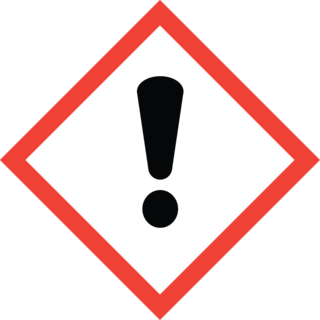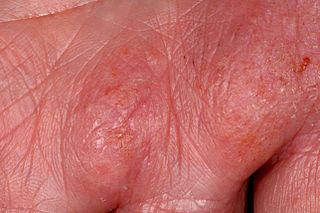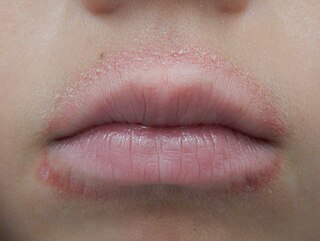Related Research Articles

Methylchloroisothiazolinone, also referred to as MCI, is the organic compound with the formula S(C2HCl)C(O)N(CH3). It is a white solid that melts near room temperature. The compound is an isothiazolinone, a class of heterocycles used as biocides. These compounds have an active sulphur moiety that is able to oxidize thiol-containing residues, thereby effectively killing most aerobic and anaerobic bacteria. MCI is often used in combination with methylisothiazolinone, a mixture known as Kathon. The isothiazolinones have attracted attention because they can cause contact dermatitis. Methylchloroisothiazolinone is effective against gram-positive and gram-negative bacteria, yeast, and fungi.

Dermatitis is a term used for different types of skin inflammation, typically characterized by itchiness, redness and a rash. In cases of short duration, there may be small blisters, while in long-term cases the skin may become thickened. The area of skin involved can vary from small to covering the entire body. Dermatitis is also called eczema but the same term is often used for the most common type of skin inflammation, atopic dermatitis.

Irritation, in biology and physiology, is a state of inflammation or painful reaction to allergy or cell-lining damage. A stimulus or agent which induces the state of irritation is an irritant. Irritants are typically thought of as chemical agents but mechanical, thermal (heat), and radiative stimuli can also be irritants. Irritation also has non-clinical usages referring to bothersome physical or psychological pain or discomfort.

Contact dermatitis is a type of acute or chronic inflammation of the skin caused by exposure to chemical or physical agents. Symptoms of contact dermatitis can include itchy or dry skin, a red rash, bumps, blisters, or swelling. These rashes are not contagious or life-threatening, but can be very uncomfortable.

Blepharitis, sometimes known as granulated eyelids, is one of the most common ocular conditions characterized by inflammation, scaling, reddening, and crusting of the eyelid. This condition may also cause swelling, burning, itching, or a grainy sensation when introducing foreign objects or substances to the eye. Although blepharitis by itself is not sight-threatening, it can lead to permanent alterations of the eyelid margin. The primary cause is bacteria and inflammation from congested meibomian oil glands at the base of each eyelash. Other conditions may give rise to blepharitis, whether they be infectious or noninfectious, including, but not limited to, bacterial infections or allergies.

Photodermatitis, sometimes referred to as sun poisoning or photoallergy, is a form of allergic contact dermatitis in which the allergen must be activated by light to sensitize the allergic response, and to cause a rash or other systemic effects on subsequent exposure. The second and subsequent exposures produce photoallergic skin conditions which are often eczematous. It is distinct from sunburn.

A moisturizer, or emollient, is a cosmetic preparation used for protecting, moisturizing, and lubricating the skin. These functions are normally performed by sebum produced by healthy skin. The word "emollient" is derived from the Latin verb mollire, to soften.

Allergic conjunctivitis (AC) is inflammation of the conjunctiva due to allergy. Although allergens differ among patients, the most common cause is hay fever. Symptoms consist of redness, edema (swelling) of the conjunctiva, itching, and increased lacrimation. If this is combined with rhinitis, the condition is termed allergic rhinoconjunctivitis (ARC).

Quaternium-15 is a quaternary ammonium salt that has been used as a surfactant and preservative. It acts as an antimicrobial agent because it slowly releases formaldehyde, which is a preservative with biocidal properties.

A patch test is a diagnostic method used to determine which specific substances cause allergic inflammation of a patient's skin.

Perioral dermatitis, also known as periorificial dermatitis, is a common type of inflammatory skin rash. Symptoms include multiple small (1–2 mm) bumps and blisters sometimes with background redness and scale, localized to the skin around the mouth and nostrils. Less commonly, the eyes and genitalia may be involved. It can be persistent or recurring, and resembles particularly rosacea and to some extent acne and allergic dermatitis. The term "dermatitis" is a misnomer because this is not an eczematous process.

Allergic contact dermatitis (ACD) is a form of contact dermatitis that is the manifestation of an allergic response caused by contact with a substance; the other type being irritant contact dermatitis (ICD).

Lotion is a low-viscosity topical preparation intended for application to the skin. By contrast, creams and gels have higher viscosity, typically due to lower water content. Lotions are applied to external skin with bare hands, a brush, a clean cloth, or cotton wool.

Benzisothiazolinone (BIT) is an organic compound with the formula C6H4SN(H)CO. A white solid, it is structurally related to isothiazole, and is part of a class of molecules called isothiazolinones. BIT is widely used as a preservative and antimicrobial.

Diazolidinyl urea is an antimicrobial preservative used in cosmetics. It is chemically related to imidazolidinyl urea which is used in the same way. Diazolidinyl urea acts as a formaldehyde releaser.

Hand eczema presents on the palms and soles, and may sometimes be difficult or impossible to differentiate from atopic dermatitis, allergic contact dermatitis, and psoriasis, which also commonly involve the hands. Even a biopsy of all these conditions may not result in a definitive diagnosis, as all three conditions may demonstrate spongiosis and crusting on the hands.
Id reactions are types of acute dermatitis developing after days or weeks at skin locations distant from the initial inflammatory or infectious site. They can be localised or generalised. This is also known as an autoeczematous response and there must be an identifiable initial inflammatory or infectious skin problem which leads to the generalised eczema. Often intensely itchy, the red papules and pustules can also be associated with blisters and scales and are always remote from the primary lesion. It is most commonly a blistering rash with itchy vesicles on the sides of fingers and feet as a reaction to fungal infection on the feet, athlete's foot. Stasis dermatitis, allergic contact dermatitis, acute irritant contact eczema and infective dermatitis have been documented as possible triggers, but the exact cause and mechanism is not fully understood. Several other types of id reactions exist including erythema nodosum, erythema multiforme, Sweet's syndrome and urticaria.
Allergen of the Year is an annual "award" voted upon by the American Contact Dermatitis Society, aiming to raise awareness about common allergens. The purpose of the award is "to draw attention to the agents causing the most significant clinical effects, those that are underrecognized and those that have become obsolete or for which exposure patterns have changed".

Nickel allergy is any of several allergic conditions provoked by exposure to the chemical element nickel. Nickel allergy often takes the form of nickel allergic contact dermatitis (Ni-ACD), a form of allergic contact dermatitis (ACD). Ni-ACD typically causes a rash that is red and itchy and that may be bumpy or scaly. The main treatment for it is avoiding contact with nickel-releasing metals, such as inexpensive jewelry. Another form of nickel allergy is a systemic form: systemic nickel allergy syndrome (SNAS) can mimic some of the symptoms of irritable bowel syndrome (IBS) and also has a dermatologic component.

Lip licker's dermatitis is a type of skin inflammation around the lips due to damage by saliva from repetitive lip licking and is classified as a subtype of irritant contact cheilitis. The resulting scaling, redness, chapping, and crusting makes a well-defined ring around the lips. The rash may extend as far as the tongue can reach and usually does not occur at the corners of the mouth. It commonly occurs during winter months but some people can have it year-round if lip licking is a chronic habit.
References
- 1 2 James WD, Berger T, Elston D (2006). Andrews' Diseases of the Skin: Clinical Dermatology (10th ed.). Philadelphia: Saunders Elsevier. p. 78. ISBN 978-0-7216-2921-6.
- 1 2 Kandola A (19 January 2020). "Eyelid dermatitis: Treatment, symptoms, and causes". Medical News Today.
- ↑ Amin KA, Belsito DV (November 2006). "The aetiology of eyelid dermatitis: a 10-year retrospective analysis". Contact Dermatitis. 55 (5): 280–285. doi:10.1111/j.1600-0536.2006.00927.x. PMID 17026693. S2CID 13581473.
- ↑ Ryder E (May 2014). Oakley A, Morrison C (eds.). "Eyelid contact dermatitis". DermNet NZ.
- ↑ Rietschel RL, Warshaw EM, Sasseville D, Fowler JF, DeLeo VA, Belsito DV, et al. (June 2007). "Common contact allergens associated with eyelid dermatitis: data from the North American Contact Dermatitis Group 2003-2004 study period". Dermatitis. 18 (2): 78–81. doi:10.2310/6620.2007.06041. PMID 17498412. S2CID 24838100.
- ↑ "Contact dermatitis - Symptoms and causes". Mayo Clinic.
- ↑ Arkadiy Yadgarov, MD; Reena A. Garg, MD (2016). "Preservative-Free Alternatives". Glaucoma Today. No. November/December. Retrieved 2022-12-11.
- ↑ Coloe J, Zirwas MJ (January 2008). "Allergens in corticosteroid vehicles". Dermatitis. 19 (1): 38–42. doi:10.2310/6620.2008.07054. PMID 18346395. S2CID 35053435.